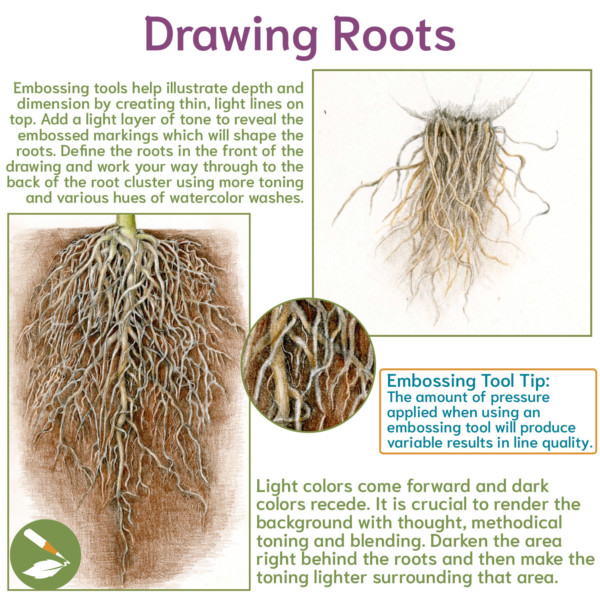Check out some of our helpful drawing tips regarding roots that we teach in our course, The Practice of Botanical Drawing!

Drawing roots is an important component of botanical drawing. Roots may seem complicated, but when you analyze their characteristics, drawing them becomes a simpler step-by-step process.
The patterns in roots are similar to those of branches and trees, veining in leaves and even the much larger patterns made by rivers and streams. Creating an exploratory sketch page of any of these patterns found in nature is a good way to begin studying roots.
To create a study page with roots, collect a plant that has roots and make sketches to understand truly see the root growth pattern. Practice line width, embossing, structure, overlaps, and toning.

Analyze the basic pattern of the root in its simplest form. To do this, look at the lines, contours and shapes of the roots. Roots are usually a combination of curvy and zigzag lines, and they are wider at the top and taper to very narrow at the bottom.
Step 1
Start by drawing the center axis, then add width. Begin to draw secondary branch roots.
Step 2
Tone each root like a cylinder, with the light source coming from the left. Create a feeling of depth by carefully toning to show overlaps.
Step 3
Once the pattern of the roots is established, more branching and fibrous roots can be added. Always refer back to the real root, but don’t worry about copying it exactly. As long as you maintain the root pattern, it will look natural and be an accurate representation of the plant’s root system. Continue to carefully tone overlaps.
Step 4
Render the background (such as soil around the roots) once the toned root drawings are complete.
Step 5
Consider the roots’ colors and how they interact with the background Remember that light colors come forward and dark colors recede. Layer colors and continue to add darks and leave highlights as needed. Add some light layers of watercolor pencil. Darken the area right behind the roots and then make the toning lighter surrounding that area. It is crucial to render the background with thought, methodical toning and blending.

Embossing tools help illustrate depth and dimension by creating thin, light lines on top. Add a light layer of tone to reveal the embossed markings which will shape the roots. Add a light layer of tone to reveal the embossed markings which will shape the roots. Define the roots in the front of the drawing and work your way through to the back of the root cluster using more toning and various hues of watercolor washes.
Embossing Tool Tip: The amount of pressure applied when using an embossing tool will produce variable results in line quality.
Light colors come forward and dark colors recede. It is crucial to render the background with thought, methodical toning and blending. Darken the area right behind the roots and then make the toning lighter surrounding that area.
Want to learn more?
Try your FIRST WEEK FREE and cancel any time with no hidden fees!



